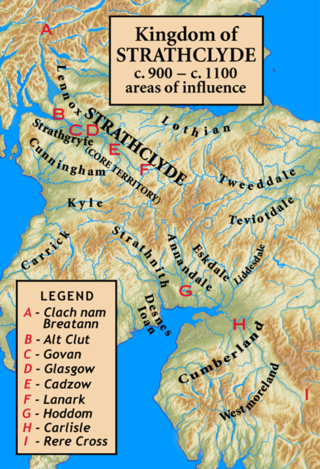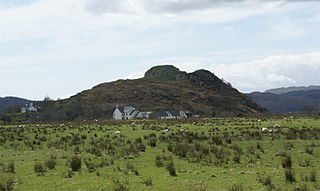
Strathclyde was a Brittonic kingdom in northern Britain during the Middle Ages. It comprised parts of what is now southern Scotland and North West England, a region the Welsh tribes referred to as Yr Hen Ogledd. At its greatest extent in the 10th century, it stretched from Loch Lomond to the River Eamont at Penrith. Strathclyde seems to have been annexed by the Gaelic-speaking Kingdom of Alba in the 11th century, becoming part of the emerging Kingdom of Scotland.

Eochaid ab Rhun was a ninth century King of Strathclyde, who may have also been King of the Picts. He was a son of Rhun ab Arthgal, King of Strathclyde, and descended from a long line of British kings. Eochaid's mother is recorded to have been a daughter of Cináed mac Ailpín, King of the Picts. This maternal descent from the royal Alpínid dynasty may well account for the record of Eochaid reigning over the Pictish realm after the death of Cináed's son, Áed, in 878. According to various sources, Áed was slain by Giric, whose ancestry is uncertain and who then proceeded to usurp the Alban throne.

The Battle of Brunanburh was fought in 937 between Æthelstan, King of England, and an alliance of Olaf Guthfrithson, King of Dublin; Constantine II, King of Scotland; and Owain, King of Strathclyde. The battle is sometimes cited as the point of origin for English national identity: historians such as Michael Livingston argue that "the men who fought and died on that field forged a political map of the future that remains, arguably making the Battle of Brunanburh one of the most significant battles in the long history not just of England, but of the whole of the British Isles."

Dunadd is a hillfort in Argyll and Bute, Scotland, dating from the Iron Age and early medieval period and is believed to be the capital of the ancient kingdom of Dál Riata. Dal Riata was a Gaelic kingdom spanning the northern Irish coast to Argyll and the Scottish islands in the early centuries AD, possibly after the Romans had abandoned Southern Britain and at the time when the Anglo-Saxons were crossing the North Sea to counter incursions over Hadrian's Wall by the Picts and Dalriadan Scots.

The Battle of Dun Nechtain or Battle of Nechtansmere was fought between the Picts, led by King Bridei Mac Bili, and the Northumbrians, led by King Ecgfrith, on 20 May 685.

Galloway is a region in southwestern Scotland comprising the historic counties of Wigtownshire and Kirkcudbrightshire. It is administered as part of the council area of Dumfries and Galloway.

The Cruthin were a people of early medieval Ireland. Their heartland was in Ulster and included parts of the present-day counties of Antrim, Down and Londonderry. They are also said to have lived in parts of Leinster and Connacht. Their name is the Irish equivalent of *Pritanī, the reconstructed native name of the Celtic Britons, and Cruthin was sometimes used to refer to the Picts, but there is a debate among scholars as to the relationship of the Cruthin with the Britons and Picts.

Navan Fort is an ancient ceremonial monument near Armagh, Northern Ireland. According to tradition it was one of the great royal sites of pre-Christian Gaelic Ireland and the capital of the Ulaidh. It is a large circular hilltop enclosure—marked by a bank and ditch—inside which is a circular mound and the remains of a ring barrow. Archeological investigations show that there were once buildings on the site, including a huge roundhouse-like structure that has been likened to a temple. In a ritual act, this timber structure was filled with stones, deliberately burnt down and then covered with earth to create the mound which stands today. It is believed that Navan was a pagan ceremonial site and was regarded as a sacred space. It features prominently in Irish mythology, especially in the tales of the Ulster Cycle. According to the Oxford Dictionary of Celtic Mythology, "the [Eamhain Mhacha] of myth and legend is a far grander and mysterious place than archeological excavation supports".

Cullen is a village and former royal burgh in Moray but historically in Banffshire, Scotland, on the North Sea coast 20 miles east of Elgin. The village had a population of 1,327 in 2001. The organs of the wife of Robert the Bruce are said to have been buried in its old kirk after her death in Cullen Castle. Robert made an annual payment to the village in gratitude for the treatment of his wife's body and its return south for burial. In 2000, the recent non-payment of this sum by the government was challenged and settled to the village's favour.

The Annals of Ulster are annals of medieval Ireland. The entries span the years from 431 AD to 1540 AD. The entries up to 1489 AD were compiled in the late 15th century by the scribe Ruaidhrí Ó Luinín, under his patron Cathal Óg Mac Maghnusa, on the island of Senadh-Mic-Maghnusa, also known as Senad or Ballymacmanus Island, near Lisbellaw, on Lough Erne in the kingdom of Fir Manach (Fermanagh). Later entries were added by others.

Bridei son of Maelchon was King of the Picts from 554 to 584. Sources are vague or contradictory regarding him, but it is believed that his court was near Loch Ness and that he may have been a Christian. Several contemporaries also claimed the title "King of the Picts". He died in the mid-580s, possibly in battle, and was succeeded by Gartnait son of Domelch.

Castle Tioram is a ruined castle that sits on the tidal island Eilean Tioram in Loch Moidart, Lochaber, Highland, Scotland. It is located west of Acharacle, approximately 80 km (50 mi) from Fort William. Though hidden from the sea, the castle controls access to Loch Shiel. It is also known to the locals as "Dorlin Castle". The castle is a scheduled monument.

The Abbey Craig is the hill upon which the Wallace Monument stands, at Causewayhead, just to the north of Stirling, Scotland.
Arthgal ap Dyfnwal was a ninth-century king of Alt Clut. He descended from a long line of rulers of the British Kingdom of Alt Clut. Either he or his father, Dyfnwal ap Rhydderch, King of Alt Clut, may have reigned when the Britons are recorded to have burned the Pictish ecclesiastical site of Dunblane in 849.

Rhun ab Arthgal was a ninth-century King of Strathclyde. He is the only known son of Arthgal ap Dyfnwal, King of Alt Clut. In 870, during the latter's reign, the fortress of Alt Clut was captured by Vikings, after which Arthgal and his family may have been amongst the mass of prisoners taken back to Ireland. Two years later Arthgal is recorded to have been slain at the behest of Causantín mac Cináeda, King of the Picts. The circumstances surrounding this regicide are unknown. The fact that Rhun seems to have been Causantín's brother-in-law could account for Causantín's interference in the kingship of Alt Clut.

Ímar mac Arailt was an eleventh-century ruler of the Kingdom of Dublin and perhaps the Kingdom of the Isles. He was the son of a man named Aralt, and appears to have been a grandson of Amlaíb Cuarán, King of Northumbria and Dublin. Such a relationship would have meant that Ímar was a member of the Uí Ímair, and that he was a nephew of Amlaíb Cuarán's son, Sitriuc mac Amlaíb, King of Dublin, a man driven from Dublin by Echmarcach mac Ragnaill in 1036.

Burghead Fort was a Pictish promontory fort on the site now occupied by the small town of Burghead in Moray, Scotland. It was one of the earliest power centres of the Picts and was three times the size of any other enclosed site in Early Medieval Scotland. The fort was probably the main centre of the Pictish Kingdom of Fortriu, flourishing with the kingdom itself from the 4th to the 9th centuries.
Ragnall ua Ímair, also known as Ragnall mac Ragnaill, was an eleventh-century King of Waterford. He appears to have ruled as king from 1022 to 1035, the year of his death.

Bar Hill Fort was a Roman fort on the Antonine Wall in Scotland. It was built around the year 142 A.D.. Older maps and documents sometimes spell the name as Barr Hill. A computer generated fly around for the site has been produced. Lidar scans have been done along the length of the wall including Bar Hill. Sir George Macdonald wrote about the excavation of the site. Many other artefacts have also been found at Shirva, about a mile away on the other side of Twechar.

Dunnicaer, or Dun-na-caer, is a precipitous sea stack just off the coast of Aberdeenshire, Scotland, between Dunnottar Castle and Stonehaven. Despite the unusual difficulty of access, in 1832 Pictish symbol stones were found on the summit and 21st-century archaeology has discovered evidence of a Pictish hill fort which may have incorporated the stones in its structure. The stones may have been incised in the third or fourth centuries AD but this goes against the general archaeological view that the simplest and earliest symbol stones date from the fifth or even seventh century AD.


















